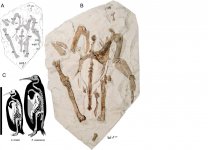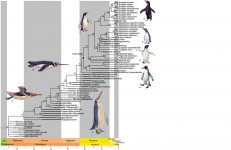Fred Ruhe
Well-known member

Simone Giovanardi, Daniel T. Ksepka & Daniel B. Thomas, 2021
A giant Oligocene fossil penguin from the North Island of New Zealand
Journal of Vertebrate Paleontology. Online edition: e1953047. doi:10.1080/02724634.2021.1953047
Abstract: https://www.tandfonline.com/doi/abs/10.1080/02724634.2021.1953047?journalCode=ujvp20
Penguins (Sphenisciformes) have arguably the most complete and continuous fossil record of any avian clade, offering an ever-improving understanding of penguin phylogeny, biogeography, and the evolution of wing-propelled diving. Yet, our knowledge of the precise body proportions of stem-group penguins remains poor due to a dearth of articulated specimens. Here, we describe Kairuku waewaeroa sp. nov., a new giant penguin species from the Glen Massey Formation (Whaingaroan stage, 34.6–27.3 Ma). The holotype skeleton, discovered in Kawhia Harbour, North Island, New Zealand, is one of the most complete skeletons of a giant penguin yet uncovered. Our phylogenetic analysis recovers a clade uniting the New Zealand endemics Kairuku waewaeroa, Kairuku waitaki, and Kairuku grebneffi, which is supported by synapomorphies including a stout femoral shaft and tibiotarsi with a distinctly convex medial condyle. Kairuku waewaeroa is unique among stem penguins in having elongate tibiotarsi, revealing a new long-legged stem penguin body plan. The discovery of Kairuku waewaeroa contributes yet another penguin species to an Oligocene avifauna for Zealandia that is replete with giant birds.
Enjoy,
Fred
A giant Oligocene fossil penguin from the North Island of New Zealand
Journal of Vertebrate Paleontology. Online edition: e1953047. doi:10.1080/02724634.2021.1953047
Abstract: https://www.tandfonline.com/doi/abs/10.1080/02724634.2021.1953047?journalCode=ujvp20
Penguins (Sphenisciformes) have arguably the most complete and continuous fossil record of any avian clade, offering an ever-improving understanding of penguin phylogeny, biogeography, and the evolution of wing-propelled diving. Yet, our knowledge of the precise body proportions of stem-group penguins remains poor due to a dearth of articulated specimens. Here, we describe Kairuku waewaeroa sp. nov., a new giant penguin species from the Glen Massey Formation (Whaingaroan stage, 34.6–27.3 Ma). The holotype skeleton, discovered in Kawhia Harbour, North Island, New Zealand, is one of the most complete skeletons of a giant penguin yet uncovered. Our phylogenetic analysis recovers a clade uniting the New Zealand endemics Kairuku waewaeroa, Kairuku waitaki, and Kairuku grebneffi, which is supported by synapomorphies including a stout femoral shaft and tibiotarsi with a distinctly convex medial condyle. Kairuku waewaeroa is unique among stem penguins in having elongate tibiotarsi, revealing a new long-legged stem penguin body plan. The discovery of Kairuku waewaeroa contributes yet another penguin species to an Oligocene avifauna for Zealandia that is replete with giant birds.
Enjoy,
Fred






